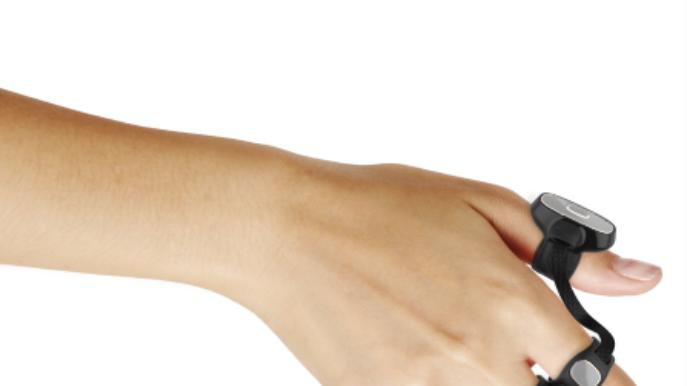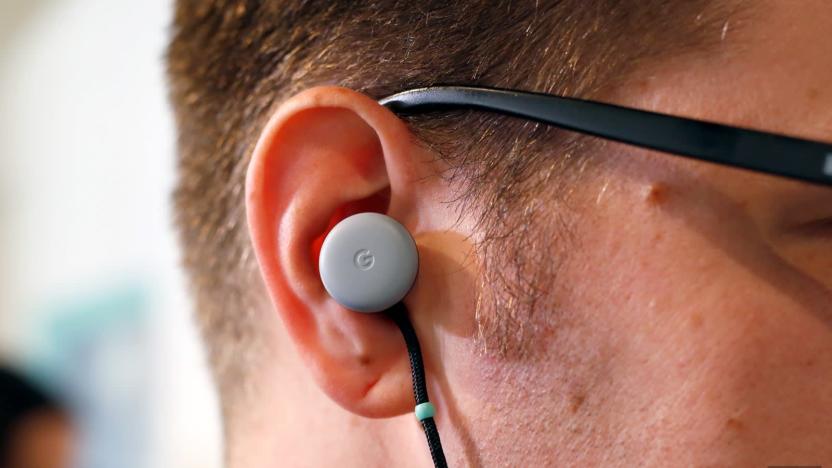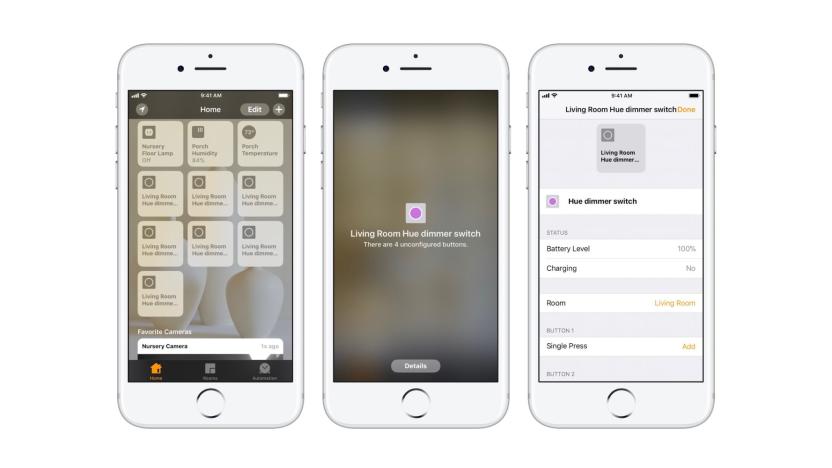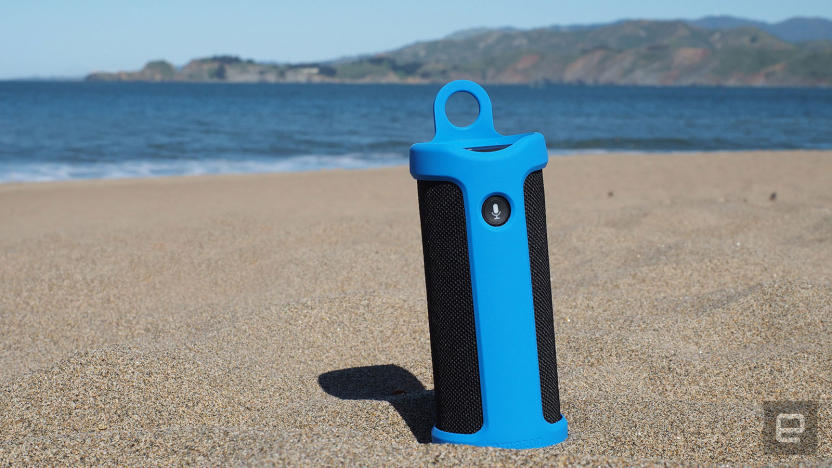tap
Latest

Kohler's Alexa-enabled Sensate kitchen faucet quenches thirst on command
In 2019, more than ever, we're expecting to see Alexa in everything. The Sensate faucet from Kohler is the latest example of where Amazon's voice assistant can find another home. To be fair, while a voice-activated microwave seems less than useful, a faucet (and the water that comes with it) seems at least a somewhat sensible application of hands-free technology.

Tap's wearable keyboard makes typing in VR applications a breeze
To date, the VR experience has largely centered around games and entertainment -- doing any actual work, such as typing up a document or sending an email, has been a slow and cumbersome process due to clunky point-and-click virtual keyboards. Now, a company behind a wearable keyboard, mouse and controller has demonstrated that its kit can be used with Microsoft's virtual desktop environment, making it easier, quicker and more intuitive to get stuff down within a VR realm.

Google adds new gestures and pairing features to Pixel Buds
While they were initially a little underwhelming, Google's Pixel Buds have gotten some new features lately, including Assistant-centric gestures like a touch and hold to start voice-command mode. Just a few days ago, the company added a way to customize which apps send spoken notifications, too. Now, Google is adding two new tap gesture capabilities and easier pairing to its earbuds. The updates are rolling out today and should be out for all by early next week.

Multitouch 'skin' makes your body the controller
Having a sophisticated computer interface on your body might seem like the stuff of science fiction, but a group of scientists at Germany's Saarland University have announced exactly that. Called Multi-Touch Skin, the material can be inkjet printed onto a plastic sticker and register a touch from multiple points at once, much like your phone or tablet does.

Philips retroactively adds extra HomeKit support to Hue
Philips has added HomeKit support to a number of existing Hue accessories, expanding their capabilities and making them easier to configure. With the latest software update Hue tap, dimmer switch and motion sensor will all be compatible with Apple' Home app. Tap and dimmer switch can now be configured with HomeKit scenes and can be used to control other accessories (not just Hue lights), while motion sensor will now appear in the Home app as a sensor that can activate both HomeKit scenes and other automations. As well as retroactively adding HomeKit features, the latest update for iOS also brings scheduled automatic updates to accessories, plus the option to reset them to their default state.

The Amazon Tap is a so-so speaker with a so-so voice assistant
The Amazon Echo has been an unexpected hit for Amazon. Since it came out a year and a half ago, the always-listening Alexa has expanded its reach beyond ordering stuff and answering questions about the weather to controlling household items and cars. Now, not too surprisingly, Amazon is integrating this winning feature into new products. Case in point: the Tap, Amazon's $130 voice-controlled Bluetooth speaker. But unlike the Echo, you have to press a button: You can't just yell a keyword to get the device to listen to random questions or commands. The result is a mediocre voice assistant in the body of a mid-range speaker.

NASA designed app aims to shorten commercial flight times
It seems as though NASA's focus as of late has been solely geared towards Mars and the efforts to get there. However the space agency recently made an announcement that hits a little closer to home. NASA has developed software to help reduce fuel consumption, carbon emissions and even cut travel times in commercial airlines. The newly introduced technology is loaded onto a tablet and won't require any major change to the already established aviation roles of pilots and ground crew meaning the technology can be implemented right away. It works by reading the planes current position in conjunction with its flight path and then looks for an alternate route that can save both time and money.

SYNEK's countertop draft system brings fresh beer home this summer
SYNEK's method for bringing draft beer to kitchen counters everywhere first caught our eye last summer, and after nabbing $650,000 in Kickstarter contributions, the final product is on the way. For the uninitiated, SYNEK developed a self-contained tap system that allows you to swap out 128 oz. bags of your favorite brew (that's just under a dozen 12 oz. pours) so that you always have fresh beer at home. You'll notice the finished model looks a bit different from the original, but rest assured that handy thermostat is still employed despite the temperature display getting moved from the front panel. And the ability to adjust CO2 levels remains inside, too. The company says that the new design also features improved insulation and makes it easier to change out those bags. There's also a removable drip tray too, so you want have to worry about getting your counter dirty.

SYNEK's countertop tap puts your kegerator out to pasture
There's no question that draft beer is the best beer, but the cost of getting fresh from the tap brews at home can be substantial. Purchasing a kegerator (along with all of its accessories), CO2 and the kegs of whatever varieties you prefer can add up quickly. But what if supplying a tap system was as easy as getting one of those reusable growlers filled? And what if the dispensing device took up minimal space on your kitchen counter? Well, that's what SYNEK is hoping to do. The draft system hinges on refillable bags that rest inside it's toaster oven-sized unit with adjustable temperature and pressure settings and easy-to-use hose connections. In the future, WiFi connectivity could be built in for monitoring supply levels and making the whole thing social amongst fellow imbibers. So what's the catch? Well, SYNEK offers a cost-effective solution for keeping a fresh beer supply around, but it'll need to convince breweries to allow bag fills before its project is ready for widespread adoption. For now though, this will resolve the headaches homebrewers face of individually topping off dozens of bottles when a five gallon batch is ready. And that's certainly worth the $349 ($299 for early adopters) retail price.

Google wants its Project Ara modular smartphone to cost $50
How much will a modular smartphone set you back? If Google gets its way, about $50 -- assuming you forgo all of the bells and whistles. The team behind Project Ara wants to launch what it calls a "grayphone," a barebones customizable exoskeleton that comes with little more than a screen, a frame and a WiFi radio. That wouldn't be much of a phone, of course, but it's only the bait. Google's Paul Eremenko told Time Techland that users would customize their underpowered husks at special kiosks outfitted with tools to help customers build the device that's right for them. Sounds bold? It is, a little; the team admitted to Time that it hasn't actually reached its price target just yet, and between the FCC and public opinion, it still has more than a few hurdles to leap before its modular cellphone is ready for market. That said, Eremenko says the focus is to make Ara great, not profitable -- a statement that adds to the nebulous handset's allure. Skip down to the attached source for Time's full rundown of Project Ara, Google's ATAP group and Eremenko's thoughts on redesigning the smartphone.

Daily iPad App: Bam Fu is frenzied fun for multiple players on one device
A while ago, I wrote about an ingenious little app named Bloop, which was a multiplayer game for one iPad, where up to four different players had to tap on little colored squares on the screen to see who could clear them off fastest. The creator of that app, Rusty Moyher, was later approached by another team of developers named Game Oven, who were then working on this app, called Bam Fu. Bam Fu is similar to Bloop, in that it too is a multiplayer game for one iOS device, and you need to hit certain colored shapes on the screen. But Bam Fu's one big innovation is that it adds a little more complexity to the game. Instead of just clearing your own color from the board, the various "stones" on the iPad's screen instead switch to the next color in the sequence when you touch them. So you might flip them one way, your opponent may flip them back, and then so on. Or you might play a little mind game, and try flipping them to your opponent's color, so that one false hit could send them back to yours. The addition of that extra mechanic makes things even more chaotic, as you have to not only hit your own color, but try to send other colors back to yours. Of course, the one drawback here is that Bam Fu isn't really a solo game -- it's meant to be played with others. But if you have some willing participants (in your family or at your next party), it's a great time, available right now for just 99 cents. Moyher originally put together Bloop as a little experiment on iOS, but the creators of Bam Fu have taken his idea and run right ahead with it.

Logitech Harmony Touch remote officially announced, brings swipe, scroll and tap LCD for $249
The cat is already well out of the bag, but we finally have some official information about the new Logitech Harmony Touch universal remote. Its first addition to the line in a while, Logitech is pushing its center-mounted 2.4-inch color touchscreen with support for control by tapping, swiping or scrolling through up to 50 channel icons as a way to "unprecedented control" of your home entertainment system. We're still not entirely sure about the transport controls being placed so far up top or the usefulness of a screen focused on direct live channel access in the DVR and streaming age (check out our thoughts on this week's podcast), but it does bring the usual control of up to 15 devices and backlit keys. Just as we saw in the stores, the price is set at $249 and it controls only via IR, not RF like the pricier Harmony 900. Check out more info in the press release after the break (along with quick demo and how-to setup videos) or on Logitech's blog, fans of the new device should be able to find them released widely in the US and Europe this month.

Logitech Harmony Touch remote pops up unannounced at Best Buy (Update: Pictures)
It's been a long time since we've seen any new blood refreshing Logitech's line of universal remotes, but after indications of new devices on the way in an earnings call earlier this year tipster Andrew spotted this brand new Harmony Touch on store shelves. Arriving at Best Buy unheralded by any official announcement or specs so far, the box shots and list of features show the ability to control 15 different devices and (of course) that center mounted touchscreen. There's no mention of it on the Logitech site either, however one leaked blog post we spotted referred to this device and a Harmony Plus. As our friends at Tech of the Hub note, the Touch clearly draws a lot of its heritage from the Harmony One and 1100 touchscreen remotes although to have ditched the dedicated Activity button for "one touch" control. The touchscreen itself supports both taps and swipes as well as up to 50 customizable channel icons, and the box lists both online setup and on-remote customization as features. According to Andrew it's rocking a price tag of $249 -- $50 above the current price of the Harmony One but $100 shy of the RF-equipped Harmony 900 -- hopefully we'll find out soon if what Logitech has added this time around makes it worth the wait. Update: Another one of our readers, Zachary also saw it at Best Buy and bought one, check out a few out of the box pics in the gallery below, and drop any questions about its capabilities in the comments. He's digging it so far, saying that the touchscreen is responsive and it found icons for his area quickly, with options to change background, LCD brightness and screen timeout. There does not appear to be any RF support however, so it's IR control only. [Thanks, Andrew]

Nukotoys introduces two physical card sets for interacting with iPad apps
One of our first appointments here at CES this week was with a company called Nukotoys, which co-CEO Rodger Raderman told us was interested in asking the question for today's children: "What is a toy?" As we've reported here before, more kids than ever are interested in getting iPod touches and even iPads as gifts, so Nukotoys wants to come up with toys and products that sit in that space, coming up with new types of toys for children to play with and learn from on Apple's devices. Raderman said his company was going after both "virtual play patterns and physical play patterns," trying to combine "the power of physical objects" with all of the virtual computing play that the iPad and its various features can offer. To that end, the company's first product consists of two lines of cards for two different apps coming up on the App Store in March. The first is an Animal Planet-branded line called Wildlands. With this system, kids will be able to buy cards (at select Walmart and Target retailers, among others) in packs of either 3 or 7. The way the game works is that the cards are pressed against the iPad's touchscreen, and then whatever animal is on the card will appear in the app's virtual savanna. The technology to make the cards work is proprietary ("it's magic," Raderman teased when pressed for exactly how it worked), but we presume it works by using capacitive touch patterns embedded (or printed) on the cards themselves. The whole process is seamless -- just a second after the card is touched to the screen, without ever using the camera, the iPad responds in kind. If there is some sort of capacitive touch pattern on the card (and again, Raderman didn't reveal at all how it works), presumably it might be spoofed by putting your fingers in the same patterns, but of course until the product is actually out and people have a chance to analyze it, we don't know exactly what's happening. At any rate, it works well -- press a card on the screen with, say, a lion on it in the Wildlands app, and boom, a lion will appear on the screen, which children can interact with, actually control from a third person view, or even pull up educational information and facts to read through. In the Wildlands set, there will also be cards like "Rain" and "Dust Storm" that will enable environmental effects, rather than actual animals. And animals will react to each other as well: Summon a gazelle and a lion, and the lion will realistically chase down the gazelle. The other title from Nukotoys will be Monsterology, drawing from UK publisher Templar Publishing's line of popular fantasy-based reference books. In this game (produced with input from a Wizards of the Coast founder and Pokemon card game creator), the cards will represent various monsters and spells, and then scanning them into the iPad adds them to a collection, which can be summoned in a turn-based strategy campaign. Across 60 levels, players will be able to fight the evil wizard Vidius Muldervane across the "Oloverse," summoning various creatures that have been "tapped" on to the screen already. If players don't want to buy real cards to tap in, there will also be virtual cards to play available via in-app purchase, but Raderman did say that the virtual cards will be weaker than the physical ones, so there's still incentive to buy the real thing. Both games will be free, but of course you'll need to buy the cards to get the full experience. Raderman points out that both games have elements of educational value to them -- the Wildlands game does have real animal facts, and the turn-based game does have some number-crunching and math elements to it (each creature has its own stats, and can be guided around the map at different speeds, depending on your current strategy or goal). Nukotoys' goal isn't just education -- their bigger goal is fun, which they say is what parents are looking for in interactive toys as well. The whole system looks very interesting. The "tap" technology is definitely intriguing, and hackers will no doubt want to rip into the cards to see exactly how the company has developed this communication through capacitive touch. Kids may get into a "collect-em-all" mindset on the games, but at launch, at least, there are 60 cards for the Animal Planet set, and 100 for the Monsterology game, so it's not a huge, overwhelming system to get into. That may change, though -- we'll see what the response is like on this one, and obviously Nukotoys has more plans for both these sets and other games in the future. We'll take another look at the game once it is released, and see if the final product in March matches up to what Nukotoys aims to do about crossing the physical and virtual space.

Unnecto TAPs into dual-SIM market, lets you do double GSM duty with a touch
Heard of Unnecto? Neither have we. But if you're oh-so-important enough to be toting around more than one phone on more than one carrier, you might want to stop, drop (some dough) and TAP -- as the company's latest smartphone is known. This sixth in a line of dual-SIM offerings is the outfit's first to offer touchscreen functionality and packs a quadband GSM radio that should make your globe- and frequency-hopping a little more efficient. No pricing or release details have yet been announced, but if you're really keen to wield this handset, you can just leave all of that tedious busywork to your office-locked assistant. Check the official presser after the break.

Volkswagen Temporary Auto Pilot brings hands-free driving to the highway
Would you feel comfortable driving down the highway with a Temporary Auto Pilot (TAP) behind the wheel of your next Volkswagen? A new technology proposed by the German automaker won't take you from A to B automatically, but it will help out with more simple driving, so you can take your hands off the wheel while cruising down the highway at up to 130km/h (about 80 mph), for example. The system pairs Lane Assist with cruise control, and can be overridden by the driver at any time. The TAP system's Pilot Mode uses radar, laser, camera, and ultrasonic sensors to maintain a safe distance between vehicles, start and stop in traffic, and slow down before a bend. Speed is set by the driver, who you'll need to remain aware of your surroundings in case you need to take over control -- so don't get too comfortable poking around the menus on that AppRadio just yet.

InputDynamics makes dumbphones smarter with tap-to-touch tech
You can't afford a proper QWERTY keyboard on your phone, much less a expansive multitouch slate. What to do? Well, if a UK startup named InputDynamics has its way, you'll just tap on any surface of your handset. The company's developed a piece of software called TouchDevice that uses a phone's embedded microphone to analyze the acoustics inside, reacting to your finger's impact on the surface with a touchscreen-like input on the device. New Scientist reports that's not all, as the algorithms can also be fine tuned for detect scratches and swipes for scrolling and zoom, and the company's in talks with "tier-one handset manufacturers" to license the program even as we speak. You'll forgive us if we're a bit skeptical, though -- if this truly requires only software and works on any surface, why not release an app to tap the backs of our Droids, BlackBerrys and iPhones?

Palm says long taps are 'meta-taps,' impresses Solaris admins worldwide
What do you call a long press in the gesture area on a webOS phone? Well, it doesn't matter, because unless you said "meta-tap" you're wrong. That's what Palm has decreed such a touch will be called and so it shall be called -- at least officially. A long press in that area plus a key, like X, C or V to cut, copy, or paste, has been given this moniker by Palm in something of a nod to the concept of a UNIX meta key, a keyboard modifier that works like the Apple Command key or Windows Alt and Ctrl keys. Why bother with the clarification? Well, for one thing, "meta-tap X" is a heck of a lot easier to type than "hold your finger in the notification area and then press X on the keyboard," and that's the sort of efficiency we can get behind.

T-Mobile Tap and webConnect Jet now available
Looking for a cheap full touch handset or a USB stick with 3G capability for T-Mobile? Heck, why not both? The self-branded Tap intro'd last month has now hit retail, bringing a 2 megapixel cam, GPS, stereo Bluetooth, and a choice of two hunger-inducing colors for $79.99 on contract. Coming alongside the Tap is the webConnect Jet USB modem, which can find its way into your shopping cart for as little as zero dollars -- $50 less than the older webConnect it slides next to in the lineup. Drop Android onto that feisty little Tap, sell it for the same price, and we're pretty sure we'd have a winner on our hands -- next year, perhaps? Read - webConnect Jet Read - T-Mobile Tap (Berry) Read - T-Mobile Tap (Midnight Blue)

T-Mobile Tap coming November 11, Samsung Behold II on November 18?
The CLIQ might be getting the lion's share of the Android spotlight on T-Mobile at the moment, but it's not the only Google-equipped gear in the carrier's pipeline -- the other big news there would be the Behold II from Samsung, a logical successor to the myTouch 3G with an AMOLED display and 5 megapixel cam. Seems like there's a little bit of a wait left, because TmoNews has scored some launch documentation suggesting that they're planning on a November 18 to get it pushed out to the public (and let's be honest, we'd all rather have that positively sick nasty myTouch Fender Limited Edition anyhow). Moving our attention downmarket, there's apparently a self-branded (read: a manufacturer you've never heard of) full touch device called the "Tap" that'll be hitting on the 11th of next month, likely slotting in below the Highlight in the carrier's range. No offense, there, Tap, but we're going to have to take a Behold II over ya.










